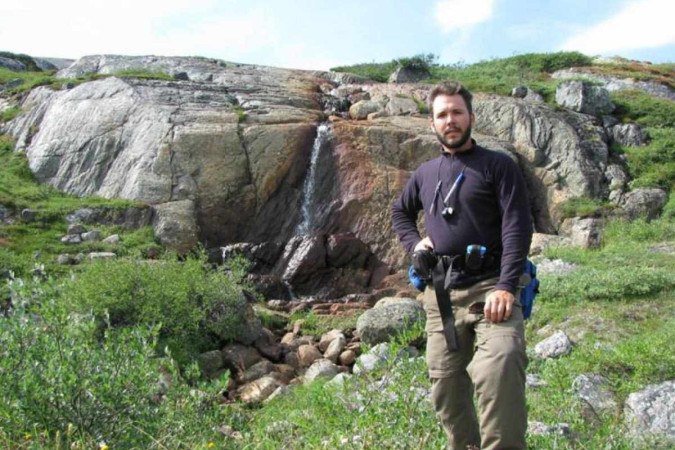Posted on 04/15/2022 06:00
(credit: University College London / publicity)
An international group of scientists says that life existed on Earth earlier than expected. The team found evidence that microbes were present in hydrothermal vents on the planet’s surface 300 million years after its formation – at least 3.75 billion years ago. The authors of the article explained in detail in the latest issue of the specialized journal Science Advances, that the discovery indicates that the conditions necessary for the emergence of living organisms are relatively basic and also strengthens the hypothesis that life exists on other planets.
To arrive at the result, experts evaluated a fist-sized boulder, taken from an area called Nuvvuagittuq Supracrustal Belt, located in Quebec, Canada. The material was collected in 2008 and is estimated to be between 3.75 billion and 4.28 billion years old. The authors detail that “the area is an ancient hydrothermal vent system, where cracks in the sea floor allow iron heated by geomagma to pass through.”
In the analysis, they cut the rock into 100-micron pieces — one micron equals one-thousandth of a millimeter — so they could observe the material’s subtle structures. Thus, they identified small hyphae, as well as other structural evidence that the substance was created by bacteria. Among the discovered shapes that indicate a sign of life are a type of trunk filled with branches about one centimeter long, and a series of deformed spheres and tubes. “All of these structures are very unique, and this indicates a biological, rather than chemical, origin, which reinforces the possibility of microbes being present in the analyzed material,” they explained.
In an interview with The Guardian, Dominic Papineau, a researcher at University College London in the UK, reports that there are some similarities between the “tree-like” trunk discovered by the group of scientists he led, and filaments made by Mariprofundus ferrooxydans, modern bacteria found in marine environments. Iron-rich deep, a special case of hydrothermal vents.
The researchers also found plenty of evidence for how the bacteria in this rock obtain energy, such as the presence of chemical by-products of the mineral. According to the team, these elements are used by microorganisms that live off iron, light, sulfur and carbon dioxide, which leads to a type of photosynthesis with the substance. Taken together, these new discoveries suggest that a diverse group of microbial life may have existed 300 million years ago after the formation of the Earth. “Geologically speaking, that’s fast. About one revolution of the Sun around the galaxy,” Papineau confirms, in a statement.
The scientific dating of the analyzed rocks indicates that they are at least 3.75 billion years old and possibly as high as 4.28 billion years old – the age of the other igneous rocks into which they were incorporated. “I think it stands to reason that this material is as old as the igneous rocks that surround it, which would be 4.28 billion years old,” says the study leader, which relied on the work of Canadian and Chinese scientists.
timetable
Prior to this discovery, the oldest fossils bearing signs of life on Earth were found in Western Australia, dating back 3.46 billion years – more than 290 million years older than the material found in Canada. According to the British team, this change in dates is closely related to the timeline of the development of life on Earth and in other regions of the universe.
“Turning back this clock is very important because it tells us that it takes very little time for life to appear on the surface of the planet. And after the formation of the Earth very quickly, there was microbial life, probably feeding on iron and sulfur in these hydrothermal vents . “, Justifies Papineau . “If life is relatively quick to emerge, under the right conditions, that increases the chance of life being found on other planets.”
A planet of three suns is disappearing
In 2016, a group of American astronomers announced the discovery of a planet four times the size of Jupiter and with three suns. In a study published yesterday in the journal Science, the team retracted. After assessments of the orb’s disappearance – made by themselves and other specialists – it was concluded that it did not exist.
The scientists reported in the paper that the light signal from the supposed planet was in fact a very distant star that was beyond the three studied suns. “It was a real hit,” said Kevin Wagner, a researcher at the University of Arizona in the US, and one of the study’s authors, in an interview with El Pais. “When we published our study, we were pretty sure. The specific spectrum, brightness, and motion of the object made it look exactly like a planet in a triple solar system. We calculated that the probability of it being a false positive was very low,” he added.
At the time of the discovery, the European Southern Observatory, owner of the telescope used by experts in 2016, announced in a statement that the new planet was even stranger than Tatooine, the fictional planet from the Star Wars saga, which had two suns in the sky. At that time, other researchers conducted analyzes in the same region as the supposed planet, in the constellation Centaurus, 320 light-years from Earth, and they were convinced of its existence.
The study’s authors point out that as difficult or embarrassing as the state of the lost planet is, it shows how scientists need to acknowledge potential errors and also make long-term analyzes, with the first study being published just 11 months later. of notes.

“Incurable thinker. Food aficionado. Subtly charming alcohol scholar. Pop culture advocate.”








More Stories
NASA Releases Selfie of Perseverance Rover Working on Mars
NVIDIA driver includes hidden Final Fantasy XVI profile
PlayStation Plus Extra and Premium saw a significant drop in players in July